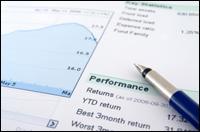 Last time we talked about the reasons you shouldn’t stay married to any one stock in your portfolio. In the “olden days,” 30 years ago, people would buy a stock and “put it away,” literally not thinking about it or even considering selling for years and years. “Buy and hold” was the philosophy of the day. Not any more.
Last time we talked about the reasons you shouldn’t stay married to any one stock in your portfolio. In the “olden days,” 30 years ago, people would buy a stock and “put it away,” literally not thinking about it or even considering selling for years and years. “Buy and hold” was the philosophy of the day. Not any more.
Therefore, you now need to think about the “why and how” of selling.
Most professional investors, and those who have done well in the stock market, will tell you that selling is much harder than buying. So a good “sell strategy” is essential if you’re going to do well in the market.
The first thing to do is put away your emotions. I know, easier said than done. But when it comes to the stock market, you really must be detached and follow the plan, rather than wildly doing what seems or feels right at the time. Too many investors have lost money because their emotions got in the way of a stock sale.
When you sell, there are only two situations: the stock has gone up or the stock has gone down. (I didn’t get my college degree for nothing, ladies!!) If the stock has gone up, your decision — before you even buy the stock — should be: what percentage of profit am I willing to take without getting greedy?
I have a friend who bought a Brazilian phone stock (sold as an ADR — American Depository Receipt — on the New York Stock Exchange), which soared after her purchase. She was up more than 46 percent in profit with this particular stock, not to mention a nice dividend payout that enhanced her earnings even more on the stock.
She thought the stock would continue to go up and up. She was wrong. It started a slippery slide south, losing almost 15 percent of its profit before she had made the decision to sell. Although she still made a hefty profit in the stock, she deprived herself of 15 percent more, by getting greedy and by emotionally deciding not to sell. She was hoping the stock was going to correct itself and move upward again.
Here’s the rub: if she had assigned a percentage of profit that she wanted to get in this stock initially, she would have lost a great deal of profit. Let’s say when she bought the stock she put a limit order in to sell when the stock went up 20 percent. Since she actually sold it for 31 percent profit, she would have deprived herself of 11 percent worth of profit. This is the downside of setting limit orders higher and lower when you buy the stock: you might miss out on some profit.
Now, let’s say she — or you — buy the stock at $50/share and are willing to lose 10 percent of the value and no more. You would put in a stop order (good ’til canceled, meaning not just for the trading day that you put in the order) at $45/share, 10 percent below the price at which you purchased it.
This way, if the stock really starts to sink like an anchor, you will only lose approximately 10 percent of your initial purchase. (I say “approximately” because a stop order becomes a market order on the way down, once it hits the stop price, and you might wind up selling it for a bit less than your stop order of $45/share.)
With limit and stop orders, you protect yourself upward and downward in any particular stock, locking in your pre-determined price at which you sell for profit or cut your losses if the stock goes down. If you predetermine a price or percentage of profit, you protect yourself by selling at the right time when the stock has reached that goal.
The work entailed is that you must constantly monitor the current price of the stock and adjust your stops and limits up or down. You move your stops because the price of the stock moves up or down, and your percentage of profit or loss therefore changes. It is not emotional, simply a mathematical way to manage your stocks.
For example, you bought the stock at $50 and your limit order to sell is at 20 percent or $60. Now, after two weeks, the stock is trading at $55/share. You must now adjust your limit price to $66/share because the stock price itself has gone up. Same principle on the downside: if you bought the stock for $50/share and put a 10 percent stop order in, then the stock moves down to $47/share, your stop order needs to be adjusted accordingly. You can do this once a week by modifying your sell orders up and down.
What does this give you? A certain peace of mind because you know your losses are limited on the downside and you won’t wind up looking at a stock that went down so violently that you lose 30 or 40 percent of its value, something which depletes a portfolio very easily and quickly. And it gives you a goal to reach for on the upside: a 20 percent profit, for example, in everything you invest in, which would make you a genius investor!
No need to get greedy or break out in hives with worry when you invest in stocks. Instead, get a fixed plan and execute it to ensure you sleep-filled nights and pleasant days.
